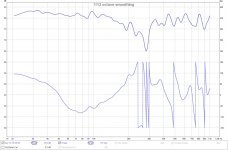Ha. What I smelled this morning was acetone though. That's what I use to clean off the PL I always manage to smear all over my hands and usually up my arm too. 🙂
Rubber gloves are your friend.
The first time I worked with polyurethane adhesive was about twenty years ago. It was the liquid kind. I wore the stuff for 2 weeks. After that it was rubber gloves.
I use it to:
https://www.youtube.com/watch?v=hhcOLiIsyWU
The first time I worked with polyurethane adhesive was about twenty years ago. It was the liquid kind. I wore the stuff for 2 weeks. After that it was rubber gloves.
I use it to:
https://www.youtube.com/watch?v=hhcOLiIsyWU
Mounted the drivers tonight and fought with JRiver to get 2 more channels running then created 4th order LR crossovers at 70 Hz and 400 Hz. Very crudely matched levels while listening to music.
It sounds really bad right now. If I increase the level enough for low frequencies to sound good high frequencies get much too loud and boomy sounding. Before I found diyaudio I would have thought something went really wrong rather than understand that this was completely predictable due to baffle step.
I snapped a pic of the chamfer on the back of the baffle cut out. Hopefully that is enough to let the woofer breath.
-Chris
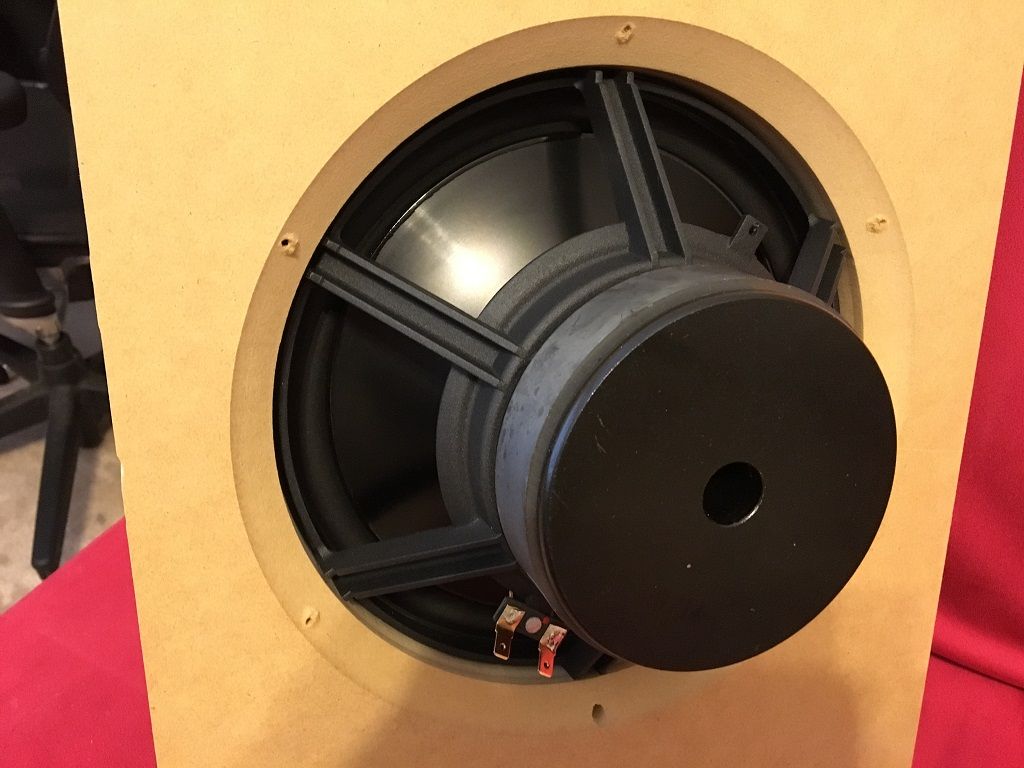
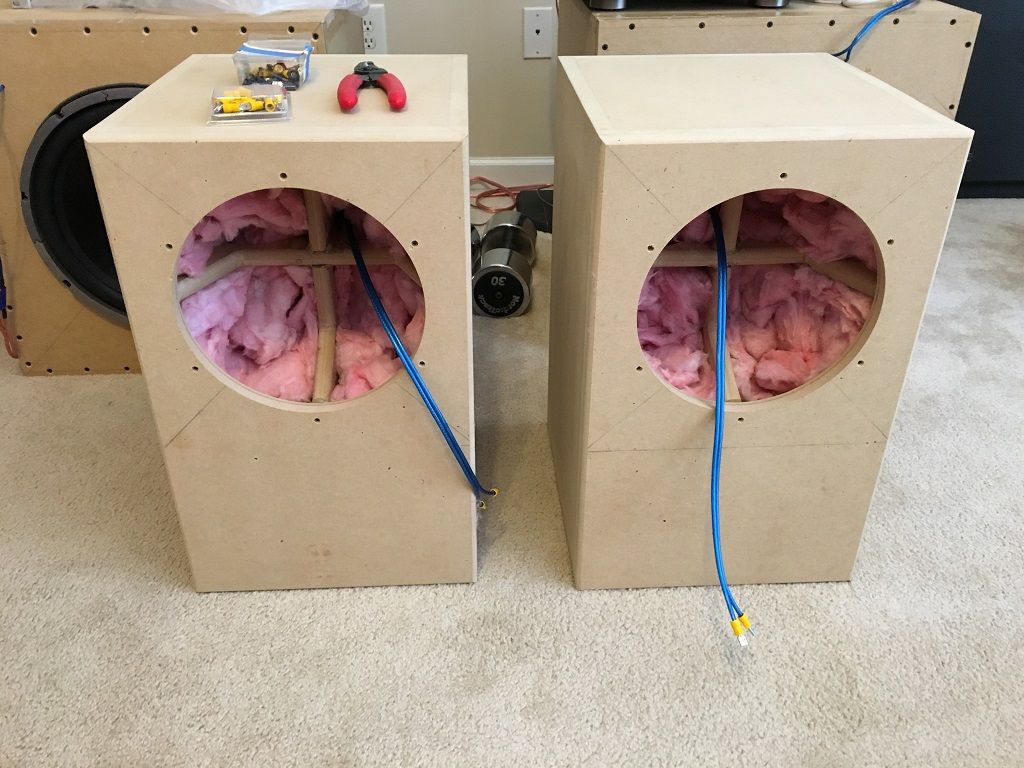
It sounds really bad right now. If I increase the level enough for low frequencies to sound good high frequencies get much too loud and boomy sounding. Before I found diyaudio I would have thought something went really wrong rather than understand that this was completely predictable due to baffle step.
I snapped a pic of the chamfer on the back of the baffle cut out. Hopefully that is enough to let the woofer breath.
-Chris


Very nice. Now you have to start the arduos task of adjusting, both position and then EQ.
I'd start with position.
I'd start with position.
They will have to run in the general area shown below as that makes the triangle with my listening position. Hopefully I can move the subs around now too.
This weekend I'm going to use rePhase to create my crossovers as FIR instead of IIR and get that going in JRiver. I'll go ahead and add a little PEQ for baffle step correction then start measuring frequency response of individual drivers and using REW to generate PEQ filters.
After that I want to spend some more time with rePhase and see how smooth I can get my phase before really dialing in my delays.
The next thing I may actually build is some diffusers to go on the wall behind the speakers. Or maybe an amp rack then diffusers.
-Chris
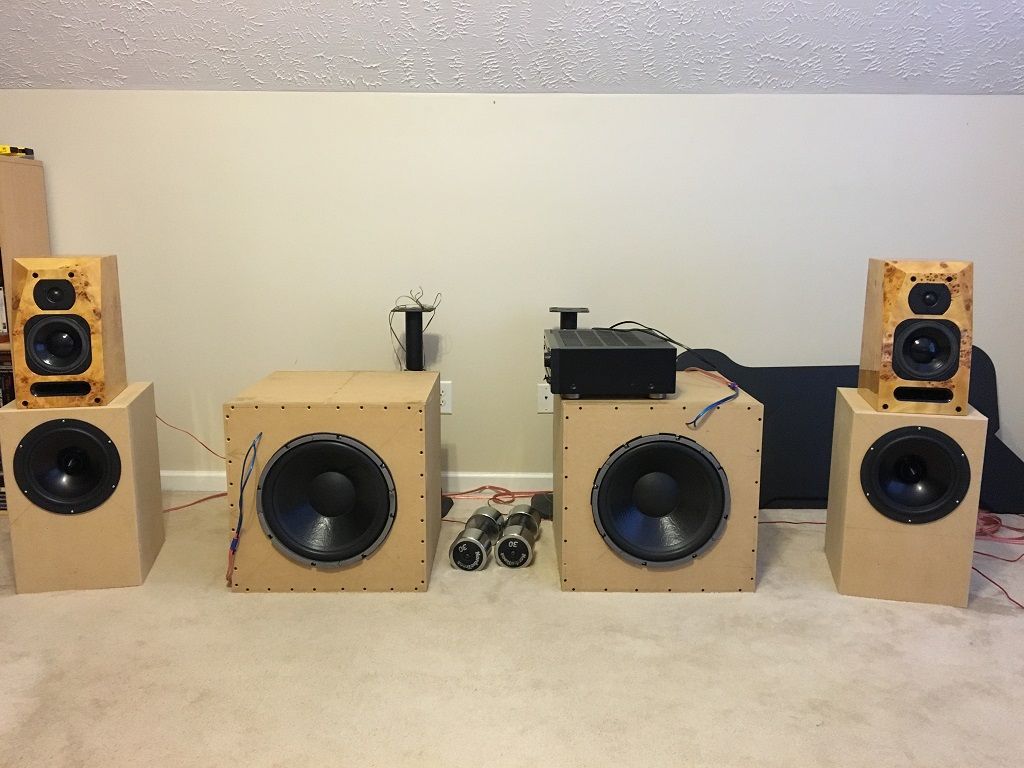
This weekend I'm going to use rePhase to create my crossovers as FIR instead of IIR and get that going in JRiver. I'll go ahead and add a little PEQ for baffle step correction then start measuring frequency response of individual drivers and using REW to generate PEQ filters.
After that I want to spend some more time with rePhase and see how smooth I can get my phase before really dialing in my delays.
The next thing I may actually build is some diffusers to go on the wall behind the speakers. Or maybe an amp rack then diffusers.
-Chris

I spent a bunch of hours yesterday messing with this. I had to order a microphone stand so I didn't do the close up driver measurements and averaging yet. But I did run some 20 - 2000 Hz sweeps and measure response at my listening position. Then I generated a few EQ filters with REW and applied them with JRiver PEQ.
After that I spent a couple full hours listening to rock music with hard hitting bass. Stuff like AC/DC, Rush, Def Leopard, Heart along with some jazz and blues. Once I dialed in some low shelf to slope the bass level up below 150 Hz, drums were sounding really good to me. I've now got that mid bass impact that was missing between my subs and mains before.
But there were some songs where something still wasn't right down around my sub to mid bass crossover point. It seemed to be with recordings where the drums were prominent at the same time as deep bass guitar with overlapping frequencies. It was just kind of muddy sounding at times.
My guess was phase/time alignment issues between the sub and midbass so I decided to use rePhase to generate linear crossovers to match the IIR filters I had configured in JRiver. I created a JRiver convolution config file based on examples in the rePhase thread and JRiver forum and it worked the first time I tried it.
I didn't think it was working right though. I played the first song and there was very little output below 400 Hz. I didn't realize that the convolution config channel maps were going to override the JRiver PEQ channel copies and adds I had setup, to get my 6 channels out of 2. Not a big deal except that I had some gain configured in there for both the subs and mid bass which was no longer being applied. And I was running my subs mono before but the convolution config had switched them to stereo.
So, I had to measure from my listening position again, tweak levels and create new PEQ filters with REW to knock down the worst peaks. Then I had to redo my low shelf to where I liked the response curve and drums were once again sounding really good. By then it was getting late but I did play a few songs that had some noticeable muddy points in the bass before. Definite improvement and I could hear separation between the bass guitar frequencies and drums.
Unfortunately I now have a nasty 20 DB dip at 70 Hz that wasn't there in my previous measurement from the same position. I believe what happened is that I had the high pass filter on the mid bass disabled when I measured the first time but I included it in the FIR filter.
I was planning to spend the afternoon washing my car and motorcycle then going for a ride but it's raining. So I'm probably going to work on a setup to allow switching between IIR and FIR crossovers easily levels and curves remaining the same. That way I can work on a high pass filter that keeps my cone excursion under control without resulting in this big 70Hz dip. Much easier to do that with the JRiver IIR filters since I can tweak slopes and frequencies in seconds.
Since I have some unexpected time I might also try getting some individual driver measurements with the little tabletop mic stand that came with my UMM-6.
-Chris
After that I spent a couple full hours listening to rock music with hard hitting bass. Stuff like AC/DC, Rush, Def Leopard, Heart along with some jazz and blues. Once I dialed in some low shelf to slope the bass level up below 150 Hz, drums were sounding really good to me. I've now got that mid bass impact that was missing between my subs and mains before.
But there were some songs where something still wasn't right down around my sub to mid bass crossover point. It seemed to be with recordings where the drums were prominent at the same time as deep bass guitar with overlapping frequencies. It was just kind of muddy sounding at times.
My guess was phase/time alignment issues between the sub and midbass so I decided to use rePhase to generate linear crossovers to match the IIR filters I had configured in JRiver. I created a JRiver convolution config file based on examples in the rePhase thread and JRiver forum and it worked the first time I tried it.
I didn't think it was working right though. I played the first song and there was very little output below 400 Hz. I didn't realize that the convolution config channel maps were going to override the JRiver PEQ channel copies and adds I had setup, to get my 6 channels out of 2. Not a big deal except that I had some gain configured in there for both the subs and mid bass which was no longer being applied. And I was running my subs mono before but the convolution config had switched them to stereo.
So, I had to measure from my listening position again, tweak levels and create new PEQ filters with REW to knock down the worst peaks. Then I had to redo my low shelf to where I liked the response curve and drums were once again sounding really good. By then it was getting late but I did play a few songs that had some noticeable muddy points in the bass before. Definite improvement and I could hear separation between the bass guitar frequencies and drums.
Unfortunately I now have a nasty 20 DB dip at 70 Hz that wasn't there in my previous measurement from the same position. I believe what happened is that I had the high pass filter on the mid bass disabled when I measured the first time but I included it in the FIR filter.
I was planning to spend the afternoon washing my car and motorcycle then going for a ride but it's raining. So I'm probably going to work on a setup to allow switching between IIR and FIR crossovers easily levels and curves remaining the same. That way I can work on a high pass filter that keeps my cone excursion under control without resulting in this big 70Hz dip. Much easier to do that with the JRiver IIR filters since I can tweak slopes and frequencies in seconds.
Since I have some unexpected time I might also try getting some individual driver measurements with the little tabletop mic stand that came with my UMM-6.
-Chris
I couldn't find my little microphone stand today so still no individual driver measurements.
I did get rid of my 70 Hz dip by tweaking the high pass crossover for the mid bass and the low pass for the subs. I ended up with the subs low passed at 80 Hz - 24 DB and the midbass high passed at 65 Hz - 12 DB. It measured pretty decent there so I spent a little time settings levels across the 3 ways I currently have implemented. Then I generated EQ filters with REW again. Ended up with the response below after applying the EQ.
I do know that I could have taken in-cabinet drivers measurements and used XSim or probably SoundEasy to calculate the crossover frequencies and slopes rather than do it trial and error. But I've learned quite a bit so I'm fine with the time I spent on it.
I didn't care much for the sound and ended up slapping a low shelf on top of it which I'm sure screwed up the phase just as bad as the original IIR crossovers. I've barely even thought about what's going on at 280 Hz. Maybe just sitting the bookshelves on the midbass cabinets with no thought about spacing or baffle diffraction could be part of it? Not going to mess with it until I have better measurements.
I'm still getting my head around what I should adjust with linear phase EQ and what should be minimum phase. I know linear phase is good for my actual crossovers. But correcting driver response should be minimum phase so I think it would actually be just fine to do with IIR filters, which are much easier to tweak. I think the response curve I'm applying with a low shelf should be done linear phase since it is pretty similar to crossovers.
But, assuming I'm on the right track with the above, I'm not so sure about trying to level out peaks caused by room modes. It seems like linear phase EQ is the way to go there though.
Lots more to learn. I'm pretty happy with these woofers and the enclosures though. Even with the volume above where I normally listen they hardly seem to be breaking a sweat.
-Chris

I did get rid of my 70 Hz dip by tweaking the high pass crossover for the mid bass and the low pass for the subs. I ended up with the subs low passed at 80 Hz - 24 DB and the midbass high passed at 65 Hz - 12 DB. It measured pretty decent there so I spent a little time settings levels across the 3 ways I currently have implemented. Then I generated EQ filters with REW again. Ended up with the response below after applying the EQ.
I do know that I could have taken in-cabinet drivers measurements and used XSim or probably SoundEasy to calculate the crossover frequencies and slopes rather than do it trial and error. But I've learned quite a bit so I'm fine with the time I spent on it.
I didn't care much for the sound and ended up slapping a low shelf on top of it which I'm sure screwed up the phase just as bad as the original IIR crossovers. I've barely even thought about what's going on at 280 Hz. Maybe just sitting the bookshelves on the midbass cabinets with no thought about spacing or baffle diffraction could be part of it? Not going to mess with it until I have better measurements.
I'm still getting my head around what I should adjust with linear phase EQ and what should be minimum phase. I know linear phase is good for my actual crossovers. But correcting driver response should be minimum phase so I think it would actually be just fine to do with IIR filters, which are much easier to tweak. I think the response curve I'm applying with a low shelf should be done linear phase since it is pretty similar to crossovers.
But, assuming I'm on the right track with the above, I'm not so sure about trying to level out peaks caused by room modes. It seems like linear phase EQ is the way to go there though.
Lots more to learn. I'm pretty happy with these woofers and the enclosures though. Even with the volume above where I normally listen they hardly seem to be breaking a sweat.
-Chris
Attachments
I've been learning more about SoundEasy along with HOLM Impulse, REW and rePhase. Taking measurements in different ways, with my speakers in different positions, and listening with various levels of response EQ and phase correction.
I keep coming back to one observation about my room and seating position. I can get a pretty flat response, without too much EQ, by pulling the speakers out away from the wall. But it takes some serious output to get enough bass for my satisfaction. Having my two big subs right in front, in between my mains, works pretty well but it screws up imaging and looks ugly.
So, below is what I'm looking at doing now. Basically go BIG with a WMTMW config for my mains, but try to still keep a modular design.
If I build this, I'm 90 percent sure the woofer modules will each have an AE SBP12-8.
As drawn in this Sketchup model each one should net right about 4 cubic feet after accounting for driver volume and bracing. The whole thing is about 65" tall as drawn. If you go back to the beginning of the thread and look at my room model, the ceiling starts at 59" so this is about as tall as I can make them. But it puts the tweeters very close to inline vertically with my home theater recliner listening positions.
The center MTM module will have a removable baffle that can be re-cut very easily so I can play around with different midrange and tweeter combinations/layouts. I tried to size it to allow up to 5.5" mids with a ribbon tweeter, if I want to try that. It has about 10 times more volume than I would expect to need.
I can flip the bass modules around to change the spacing and adjust the distance between modules as well as angle the woofers in. I know the separate boxes moves me in the wrong direction when it comes to vertical lobing issues but I'm hoping all the adjustment possibilities will be enough to make it work in my room. Especially with my ceiling shape and fairly small sweet spot goal for listening.
-Chris
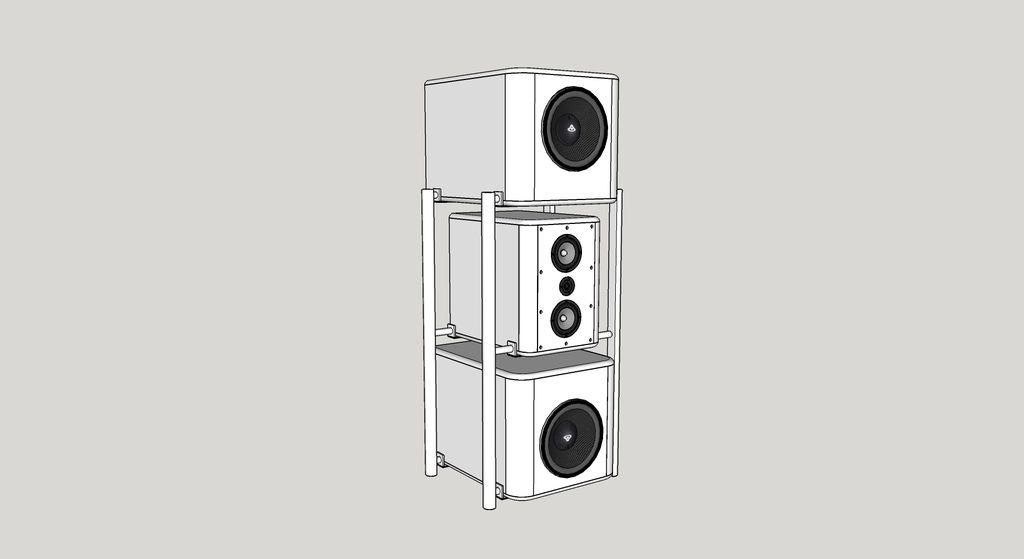
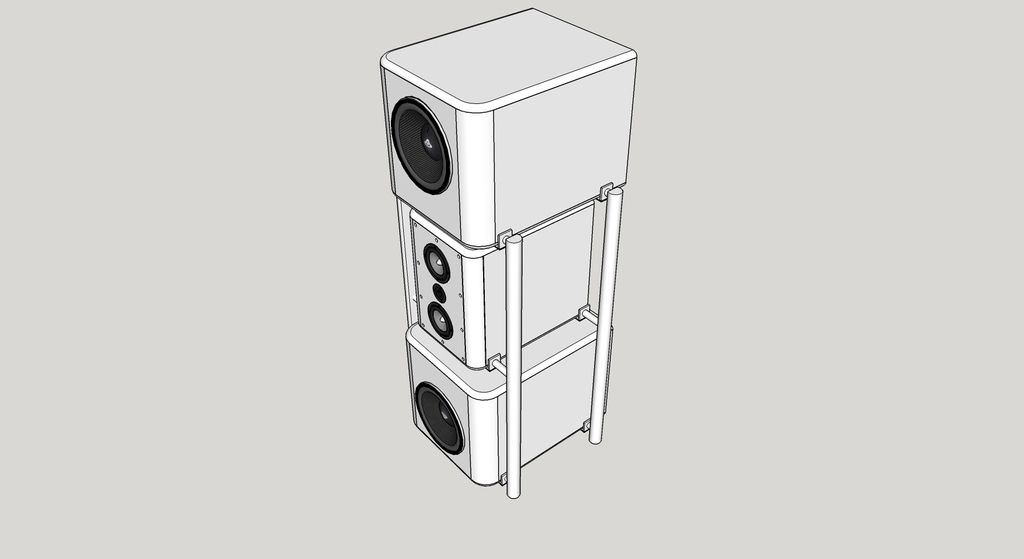
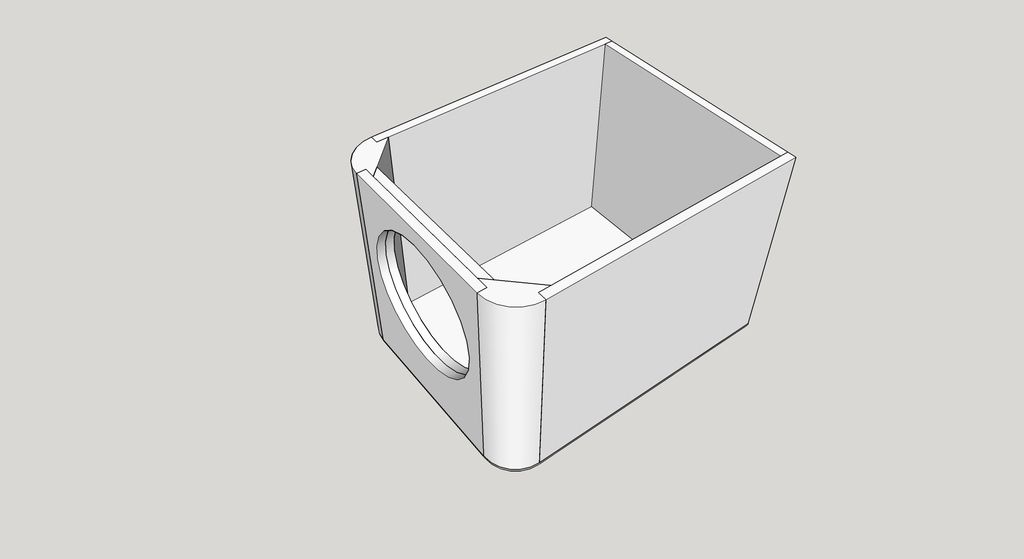
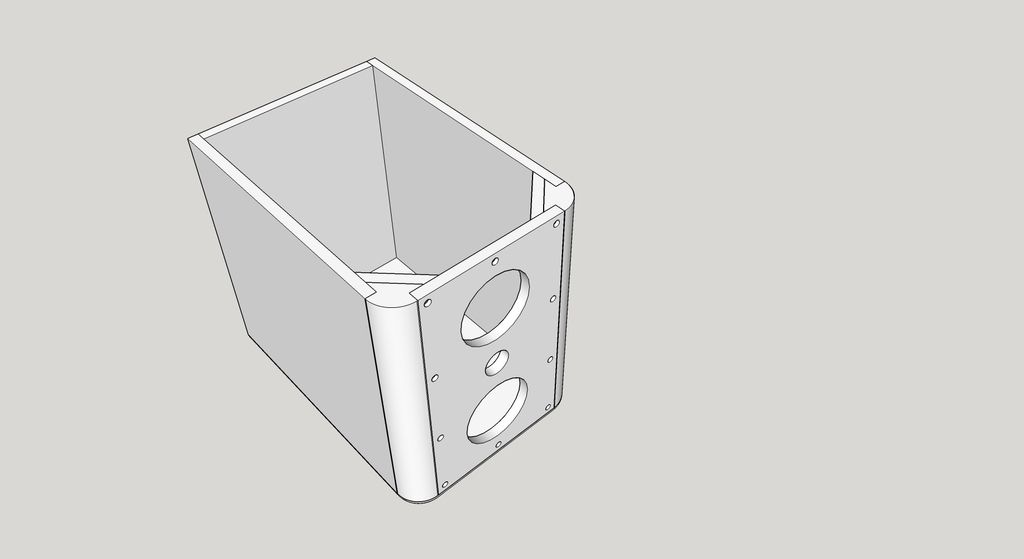
I keep coming back to one observation about my room and seating position. I can get a pretty flat response, without too much EQ, by pulling the speakers out away from the wall. But it takes some serious output to get enough bass for my satisfaction. Having my two big subs right in front, in between my mains, works pretty well but it screws up imaging and looks ugly.
So, below is what I'm looking at doing now. Basically go BIG with a WMTMW config for my mains, but try to still keep a modular design.
If I build this, I'm 90 percent sure the woofer modules will each have an AE SBP12-8.
As drawn in this Sketchup model each one should net right about 4 cubic feet after accounting for driver volume and bracing. The whole thing is about 65" tall as drawn. If you go back to the beginning of the thread and look at my room model, the ceiling starts at 59" so this is about as tall as I can make them. But it puts the tweeters very close to inline vertically with my home theater recliner listening positions.
The center MTM module will have a removable baffle that can be re-cut very easily so I can play around with different midrange and tweeter combinations/layouts. I tried to size it to allow up to 5.5" mids with a ribbon tweeter, if I want to try that. It has about 10 times more volume than I would expect to need.
I can flip the bass modules around to change the spacing and adjust the distance between modules as well as angle the woofers in. I know the separate boxes moves me in the wrong direction when it comes to vertical lobing issues but I'm hoping all the adjustment possibilities will be enough to make it work in my room. Especially with my ceiling shape and fairly small sweet spot goal for listening.
-Chris




The closer the spacing the better the possible outcome.
That goes for all the drivers actually.
That goes for all the drivers actually.
The closer the spacing the better the possible outcome.
That goes for all the drivers actually.
Thanks, Mark. I've been reading up on D'Appolito and I know you're absolutely right. From what I've read, less than 1/4 wavelength CTC between drivers is optimal but hardly anyone ever actually gets there.
I'm going to take this slow and do plenty of modelling before going at it. I'll probably order a single SBP12-8 soon and build one of the woofer modules to measure and see how it works.
I'm probably going to rig up something to take my two current mid bass modules and space the woofers vertically like the pictures above. My biggest worry is how the dual 12's will interact with each other while playing the same frequency range. I should be able to get a decent idea by spacing my 10's CTC like I want to run the 12's and removing my high pass plus turning off my subs.
The more I learn the more I admire the tall floor standers you posted earlier in the thread. I went off and studied transmission line designs for a few evenings before deciding the enclosure would have to be too big to do it with 12's.
That back loaded horn you did is cool.
-Chris
Between work and going on vacation I haven't had a lot of time to mess with speakers. I did decide to simplify from what I posted on the last page. Instead of separate modules I'm probably going to do a single cabinet. I might do 3 removable baffle sections or I may just build a single baffle and redo the whole thing if it doesn't work out the way I expect.
Also decided to go ahead and order a couple AE SBP12 woofers and Scan-Speak Illuminator 12MU mids to play with. Should have both in my hands within a week or two. Not at all sure what tweeter I want to go with yet.
So below is what I'm looking at building as a single prototype soon. I'll buy pre-formed MDF for the front corner radius so I should be able to build one enclosure over two or three weekends.
I spent all afternoon yesterday figuring out how to model the whole 5 driver baffle in SoundEasy. Thought I had said all the right magic words to get polar plots but hit the button and got an error. Shouldn't be too hard to figure out what I did wrong.
-Chris
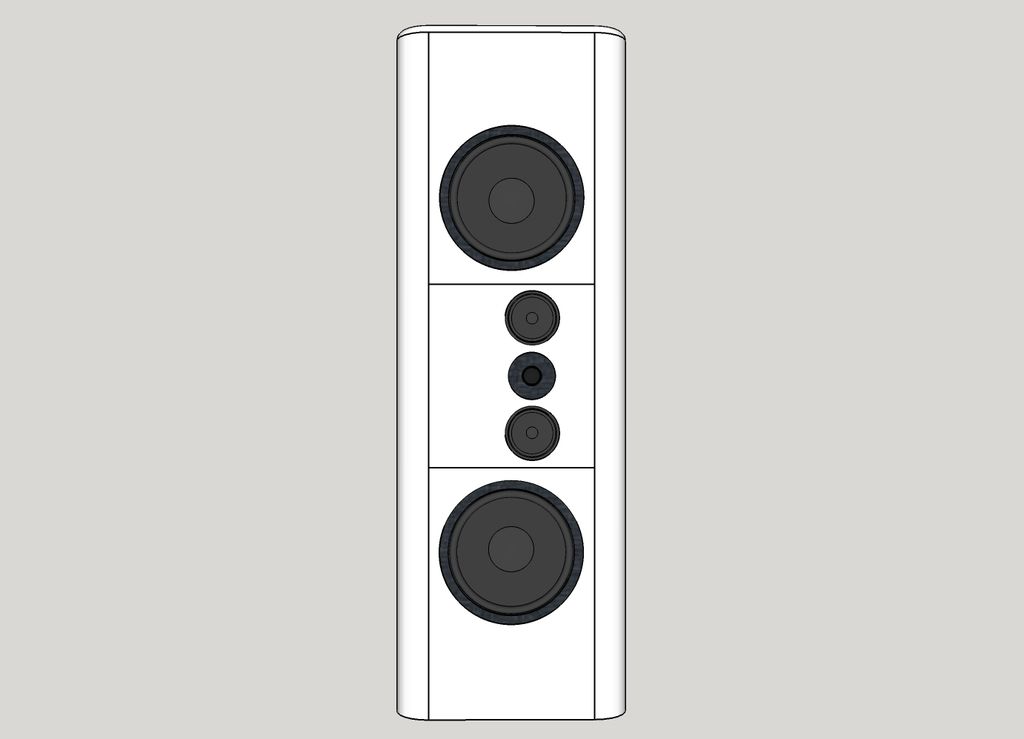
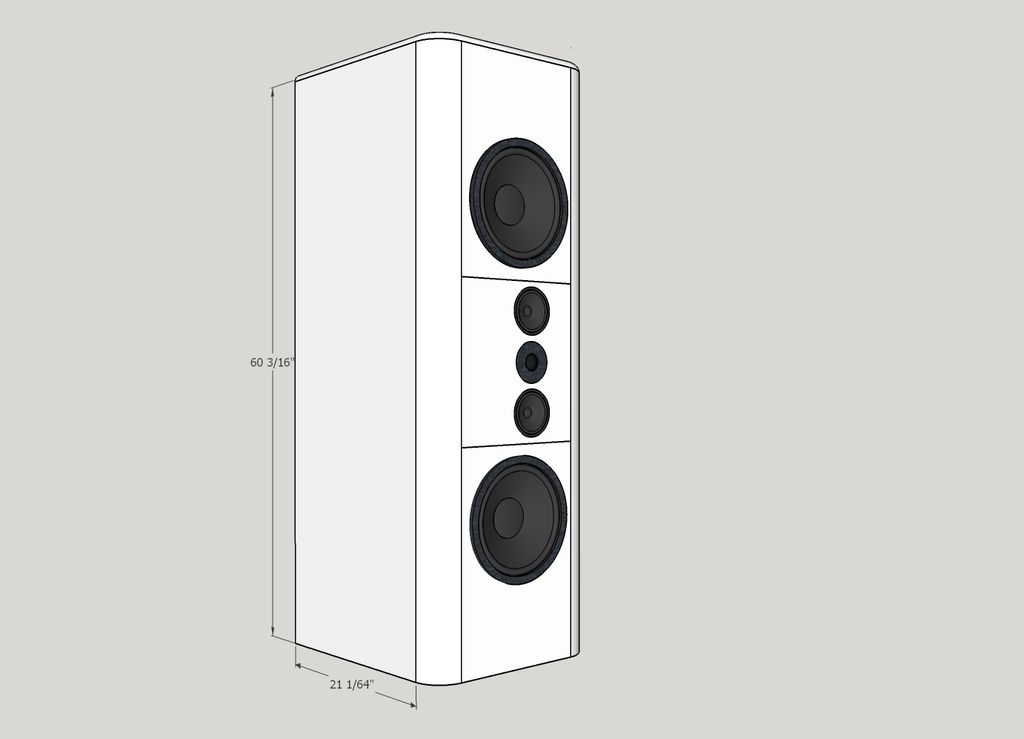
Also decided to go ahead and order a couple AE SBP12 woofers and Scan-Speak Illuminator 12MU mids to play with. Should have both in my hands within a week or two. Not at all sure what tweeter I want to go with yet.
So below is what I'm looking at building as a single prototype soon. I'll buy pre-formed MDF for the front corner radius so I should be able to build one enclosure over two or three weekends.
I spent all afternoon yesterday figuring out how to model the whole 5 driver baffle in SoundEasy. Thought I had said all the right magic words to get polar plots but hit the button and got an error. Shouldn't be too hard to figure out what I did wrong.
-Chris


My biggest worry is how the dual 12's will interact with each other while playing the same frequency range. I should be able to get a decent idea by spacing my 10's CTC like I want to run the 12's and removing my high pass plus turning off my subs.
Take a simple rule of thumb about wavelength of sound and the distance between your drivers and you will quickly find out that the two woofers are actually acting as one unit over the greater part of their range of use.
343 meters per second. You divide the speed number by the frequency in hertz to get the wavelength.
If you want feet multiply the 343.2 x 3.281 = 1126.125 feet per second.
1126.125 / 30 hertz = 37.53 feet 60 hertz is half of that, 120 hertz again half 240 hertz half again.
The more I learn the more I admire the tall floor standers you posted earlier in the thread. I went off and studied transmission line designs for a few evenings before deciding the enclosure would have to be too big to do it with 12's.
That back loaded horn you did is cool.
Thanks. There is quite a difference between a back loaded horn and a transmission line.
And yes designing a good one takes a bit of horse sense and quite a bit of experience.
But I learned how to do it. So can you.
In a back loaded horn two 12 are a bit of overkill. I've done pretty impressive bass with four 3.5 inch drivers in a back loaded horn.
Check out some past DIY Audio Ottawa threads and you will find a demo I did a few years ago that knocked off a few socks.
http://www.diyaudio.com/forums/clubs-events/199025-diy-ottawa-winter-2012-a-5.html#post2894215
Comments are below from attendees.
Those 12" woofers start showing vertical lobing above 500Hz. If and obviously as you cross lower, the will be no problems, but either hardly any benefit concerning floor bounce. This based on simulation in The Edge Home of the Edge
Check out some past DIY Audio Ottawa threads and you will find a demo I did a few years ago that knocked off a few socks.
http://www.diyaudio.com/forums/clubs-events/199025-diy-ottawa-winter-2012-a-5.html#post2894215
Comments are below from attendees.
Those look interesting to be producing the bass mentioned in comments. That's a ribbon tweeter on the front, right?
-Chris
Those 12" woofers start showing vertical lobing above 500Hz. If and obviously as you cross lower, the will be no problems, but either hardly any benefit concerning floor bounce. This based on simulation in The Edge Home of the Edge
My plan is to cross from woofers to mids at about 250Hz. Then from the mids to whatever tweeter I choose no higher than 2kHz.
In the Sketchup drawing above there's enough room for the woofers to have over 5 cubic feet each with a ton of internal bracing. But they don't need more than about 3.5 each from the modelling I've done in SoundEasy. I could reduce the overall height by several inches but the mids and tweeter are just about perfectly in line with my listening position the way I have it drawn right now
If I really like the results from the prototype I might get more adventurous and curve the sides to a narrow back. So I want to be sure I would still have enough internal volume after doing so. I'll probably build some simple cubes to put inside the prototype and reduce internal volume.
-Chris
Those look interesting to be producing the bass mentioned in comments. That's a ribbon tweeter on the front, right?
-Chris
Planar magnetic. The difference is that a ribbon has the electrical conductor as the actual diaphragm. A planar magnetic has conductors on a flexible diaphragm of another type of material. Planars tend to be a little more robust than ribbons. And also they can be made more effectively with a larger surface area without the need of an impedance matching transformer to keep them in the realm of usable with normal power amplifiers.
Broad band efficiency of that setup was 96db. The final version will be higher yet.
That has been planned out and waiting on drivers. The story of my life. All ideas and no money! Funding my own R&D is not a cheap way to do things.
What is your tweeter height?
And can you grab a tweeter with a smaller O.D. that will allow your midwoofers to be closer together?
Vifa and Scanspeak make a nice small tweeter.
Planar magnetic. The difference is that a ribbon has the electrical conductor as the actual diaphragm. A planar magnetic has conductors on a flexible diaphragm of another type of material. Planars tend to be a little more robust than ribbons. And also they can be made more effectively with a larger surface area without the need of an impedance matching transformer to keep them in the realm of usable with normal power amplifiers.
Broad band efficiency of that setup was 96db. The final version will be higher yet.
That has been planned out and waiting on drivers. The story of my life. All ideas and no money! Funding my own R&D is not a cheap way to do things.
Cool. I have a pair of planer magnetic headphones that I really like a lot. Hifiman HE400i
What is your tweeter height?
And can you grab a tweeter with a smaller O.D. that will allow your midwoofers to be closer together?
Vifa and Scanspeak make a nice small tweeter.
As drawn in the Sketchup above, the tweeter center is at 30", which is a couple inches lower than where my ears are when sitting in my home theater recliners.
I can definitely squeeze the mids closer together than they are in that drawing. I modeled the faces of a SBP12 and a 12MU so those are to scale, but I don't know what tweeter I'll use so I just drew a generic one and kinda worst cased it on size.
I've been looking at the ScanSpeak Beryllium dome tweeters. The D3004/6040 would let me get the mids much closer together.
One of the things I have to study is why so many high end tweeters have such wide face plates. I know a few incorporate wave guides but that doesn't seem to be the case for most. I'm guessing the wide plates help control diffraction at higher frequencies. So I want to understand if I lose that by just flush mounting a smaller profile tweeter.
-Chris
As drawn in the Sketchup above, the tweeter center is at 30", which is a couple inches lower than where my ears are when sitting in my home theater recliners.
I can definitely squeeze the mids closer together than they are in that drawing. I modeled the faces of a SBP12 and a 12MU so those are to scale, but I don't know what tweeter I'll use so I just drew a generic one and kinda worst cased it on size.
I've been looking at the ScanSpeak Beryllium dome tweeters. The D3004/6040 would let me get the mids much closer together.
One of the things I have to study is why so many high end tweeters have such wide face plates. I know a few incorporate wave guides but that doesn't seem to be the case for most. I'm guessing the wide plates help control diffraction at higher frequencies. So I want to understand if I lose that by just flush mounting a smaller profile tweeter.
You must be measuring that in a reclining position. Years back I measured quite a few clients for custom work. From 4'10" to 6'4" in height and the ear heght on a standard chair or sofa was between 37 and 39 inches. We humans tend to be rather consistent on some dimensions. Body trunk height being one of them. Or perhaps your recliners are low to the ground. A recliner I could probably not get out of should I sit down in it!
I had a sofa like that back as a youngin. Could sit down in it. But had to roll out of it!
Face plate.
Well simplest answer is that it was larger in times past becasue the magnets were larger. And you needed a mounting flange to attach the driver.
With Neodymium magnets there is potential to make the tweeter motor much more compact.
In fact if you are a bit creative you can rear mount the tweeter and be rid of any mounting flange.
That would require a plate to mount the woofers and the tweter on for easy access.
As for throwing monkey wrenches into your works.
If you have any designs on producing a back loaded horn drop me a line.
Might make your desire for a sub and two large 12 inch drivers per side kind of evaporate!
Thanks, Mark.
We do normally listen with the recliner back so it puts our ears lower. Still though, it might make sense to have the tweeter a couple inches above that height rather than a couple inches below.
I shifted everything up 4.5 inches on the baffle model in SoundEasy and the diffraction actually got a tiny bit smoother. Hopefully I'll have some time soon to add the additional driver data SoundEasy wants so it will give me nice polar plots and maps.
I know you're right that more advanced enclosure designs don't need the kind of brute force cone area I'm throwing at this. But it looks like I can get what I'm looking for in my room this way with a fairly simple and easy to build enclosure.
I'm sure this speaker is old school, simplistic and boring to you experienced guys. But it's my old school, simplistic speaker design and that means a lot to me. I do sincerely appreciate the help and advice I've been given in this thread and elsewhere on DIYA though. Six months ago I had no idea what baffle step/diffraction was and not a clue about why I would want to look at a polar plot or care at all about off axis response.
Another 6 months of studying and maybe I'll be ready to try a back loaded horn. 🙂
-Chris
We do normally listen with the recliner back so it puts our ears lower. Still though, it might make sense to have the tweeter a couple inches above that height rather than a couple inches below.
I shifted everything up 4.5 inches on the baffle model in SoundEasy and the diffraction actually got a tiny bit smoother. Hopefully I'll have some time soon to add the additional driver data SoundEasy wants so it will give me nice polar plots and maps.
I know you're right that more advanced enclosure designs don't need the kind of brute force cone area I'm throwing at this. But it looks like I can get what I'm looking for in my room this way with a fairly simple and easy to build enclosure.
I'm sure this speaker is old school, simplistic and boring to you experienced guys. But it's my old school, simplistic speaker design and that means a lot to me. I do sincerely appreciate the help and advice I've been given in this thread and elsewhere on DIYA though. Six months ago I had no idea what baffle step/diffraction was and not a clue about why I would want to look at a polar plot or care at all about off axis response.
Another 6 months of studying and maybe I'll be ready to try a back loaded horn. 🙂
-Chris
- Status
- Not open for further replies.
- Home
- Loudspeakers
- Multi-Way
- My attempt at 4-way digital active
